I wrote last time about the benefits of planting natives in our yards. (link)
With a few notable exceptions, most American yards, ornamental plantings, and crops over the last fifty years have been introduced plants from outside North America. Settlers brought their favorite plants with them. Furthermore, local plants were boringly familiar, exotic plants were much more interesting.
Now we want to change that, add lots of natives to our landscapes. And, natives are no longer boring and familiar because they have been so thoroughly displaced. Tulips and lilacs are familiar, sulphur flower and holly grape are not.
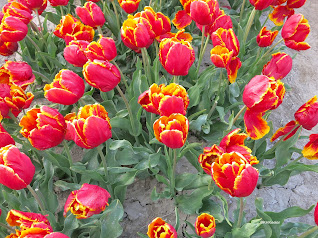 |
| tulips, Tulipa |
 |
| sulphur flower, Eriogonum umbellatum |
When we want to add natives to our yards, where do we get them? Usually from a garden store.
Yes, of course you can gather seeds or transplant wild natives. For that, you have to live where the plants you want grow. It is another statement about the condition of North America that many people do not live where they have easy access to native plants growing wild. In many cases, any nearby native plants are in protected areas such as parks, where it is illegal to dig them up.
Collecting seeds has long been common, but as people come to outnumber native plants, gathering seeds becomes ethically questionable. Most of our parks are very busy. If everyone took even one seed, there would be none left to maintain the plant population.
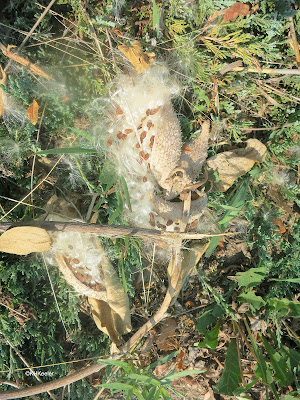 |
| seeds of showy milkweed (Ascleipias speciosa) |
Furthermore, humans are not the only users of seeds. Birds, insects, and mammals all rely on seeds. If we gather the seeds we find on our hikes, we reduce the resources for those animals as well as endangering the plant population.
So we turned to seed and plant suppliers.
Having native plants available to buy and plant is harder than it sounds. We can quickly pass a good idea around--plant natives! It takes much longer for seed and plant sellers to produce enough seeds or plants to meet a suddenly spiking demand.
Today you can find all kinds of milkweeds, genus Ascelpias, for sale. Seven years ago when I wrote a blog about where in Colorado to find milkweeds to grow for monarch butterflies, only some local nurseries had them, and at most three species. The plant industry has responded to the demand and all kinds of choices are available today, but it took time for plants to grow and set seeds and their seedlings to produce more seeds.
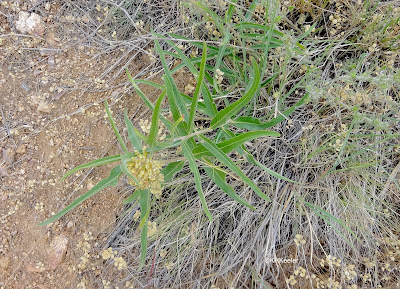 |
| This is slimleaf milkweed, Asclepias stenophylla, and seeds are for sale online. |
The first problem as everyone was encouraged to grow natives was to figure out what is native in a particular spot. Before that, "wildflower" was a selling point for seed companies and their North American wildflower mixes had plants from all across the continent. But the continent is large and diverse. Most California native wildflowers that were confined to California (and maybe southern Oregon) at settlement, the California poppy (Eschscholzia californica) for example, and were not found elsewhere. Likewise the columbines of the Rocky Mountains are all different species from the columbine (wild columbine or red columbine, Aquilegia canadensis) of the eastern U.S. Currently there are big websites, at National Wildlife Federation (link), at the Audubon Society (link), that will recommend native plants for you based on your zip code. (They're still pretty general. "Sagebrush" got me more species of Artemisia than I think lived what is now my zip code, like the two that grow over 10,000', but a whole lot fewer than all the species even in Colorado.)
So, getting an idea of which plants are native is very much easier than a few years ago. I like looking at the Flora of Colorado for my county in the distribution maps, checking for habitat preferences (my yard is not a marshy area) and elevation (if it is found at 10,000-12,000' it probably will not appreciate conditions at 5,000') but zip code based search engines have rapidly gotten better. (And, what a big problem the online sites are dealing with, matching the U.S.'s approximately 13,500 native plants to the U.S.'s 41,704 zip codes.)
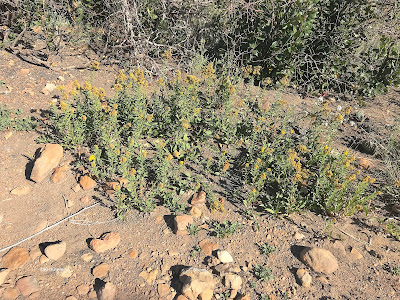 |
| A big wild goldenrod (Solidago) in gravely Colorado soil |
Which is not to say that all the natives you can buy will thrive anywhere in your back yard. Some naturally grew under other plants. Some succeeded by growing on soils too shallow for competitors. And, of course, the soil in my backyard is very much modified from the prairie that was there 100 years ago.
 |
| Little cryptantha, Cryptantha minima and interesting grasses on a surface that keeps other plants out |
Growing natives is full of surprises for most of us. Listen to local native plant experts. For example, the soils of the Colorado Front Range were dry, full of stones, and acidic. There was little organic matter. For natives, those are the soils to use, not thick topsoil rich in compost. That is hard for me, after years of making and applying compost. Most places the soil will be more like the western European soils my ancestors farmed on, but question your assumptions about gardening when converting to natives.
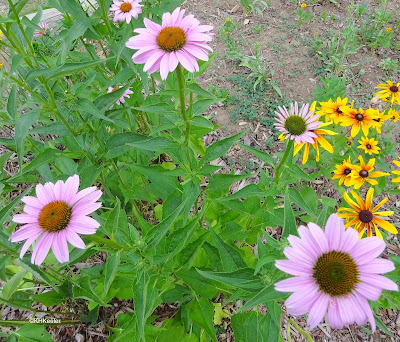 |
| natives are beautiful |
The latest critique of our familiar gardening practices goes "do not buy cultivars." A cultivar is a native plant that some plant breeder has modified. Plant breeders have created shorter, taller, or leafier plants, or ones with red flowers when the wild ones were yellow. They have selected for disease resistance. They have created wrinkled petals where the wild ones are flat, or ones with lots of extra petals. The critique warns you that native insects will not like cultivars. That is probably in some cases, however, the story is complex. I will discuss it detail next post.
Comments and corrections welcome.
Reference
Ackerfield, J. 2023. Flora of Colorado. 2nd edit. BRIT Press, Fort Worth, Texas.

No comments:
Post a Comment